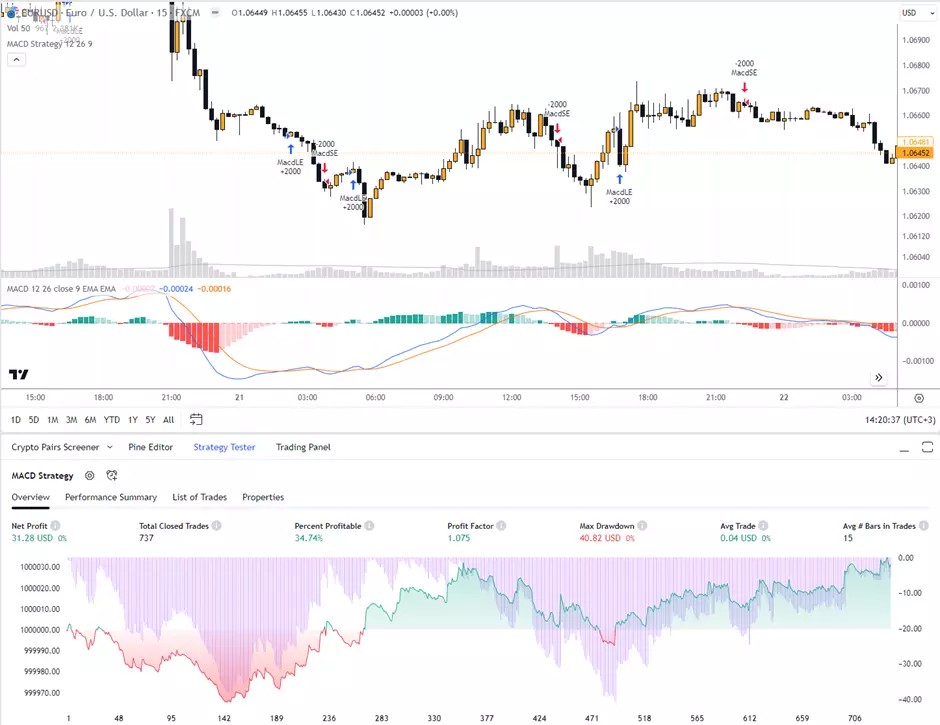How To Find Out Which Indicator Is The Best For Trading EUR/USD?



Editorial Note: While we adhere to strict Editorial Integrity, this post may contain references to products from our partners. Here's an explanation for How We Make Money. None of the data and information on this webpage constitutes investment advice according to our Disclaimer.
4 steps to find out which indicator is the best for trading EUR/USD:
Finding the best indicator for trading EUR/USD requires a practical and systematic approach. This guide, crafted with insights from a professional trader, outlines four essential steps to help you identify indicators that suit your trading strategy.
There isn’t a single best indicator for all traders due to two key reasons. Markets are constantly changing, and every trader has unique circumstances, strategies, and levels of risk tolerance. To identify what works for you, it’s important to test each one and optimize its settings to match your specific trading needs. Follow these steps to find the right fit for your EUR/USD trading approach.
What indicators are the best for trading EUR/USD?
In the world of trading, relying solely on widely accepted indicators may not guarantee success. Here are key reasons why you should personally seek out the best indicator for your EUR/USD trading strategy.
Market dynamics change. The financial markets are dynamic and subject to constant shifts. An indicator hailed as the best may suddenly lose its effectiveness due to changing market conditions. You can check regular EUR and USD forecasts.
Personalized preferences. Every trader has unique risk tolerance levels, trading frequency, and time constraints. The best indicator for you depends on your specific preferences and circumstances.
Continuous testing. Markets are not static, and what worked in the past may not work in the future. Regularly testing and evaluating different indicators is essential to ensure they remain effective and relevant to your trading strategy.
Step 1. Make a list of indicators to test
There is a vast array of indicators available to traders seeking to navigate the complex EUR/USD currency market. There are various top indicators you can follow to create a list of indicator tests. Among the classic indicators are widely recognized tools like:
Moving Averages (including Simple Moving Averages and Exponential Moving Averages), which smooth out price data to reveal trends.
The Relative Strength Index (RSI) measures the speed and change of price movements, aiding in identifying overbought or oversold conditions.
The Stochastic Oscillator offers insights into potential reversals, while Bollinger Bands helps assess volatility and potential price breakouts.
The MACD (Moving Average Convergence Divergence) combines trend-following and momentum indicators, and Fibonacci Retracement Levels help pinpoint potential support and resistance areas.
The Ichimoku Cloud, a comprehensive indicator, offers a full view of support, resistance, and trend direction, making it a versatile tool.
In the realm of less common indicators, traders may explore tools such as the:
Average True Range (ATR) to gauge volatility.
Williams %R for determining overbought/oversold conditions.
The Parabolic SAR (Stop and Reverse) to identify potential trend reversals.
Volume Weighted Average Price (VWAP) which considers both price and volume in its calculations.
Donchian Channels which highlights price breakouts.
The Chande Momentum Oscillator (CMO) that measures momentum.
Keltner Channels that provide insights into price volatility and trend strength.
The choice of indicators is very large, and you would like to know for what purpose they are designed before trying to use them.
Step 2. Conduct the testing
To conduct testing, a system or trading platform is needed that will allow you to implement and run your chosen algorithm or trading advisor based on the selected indicator. The system should also provide access to historical data for the currency pair you're interested in, such as EUR/USD.
For example, this is how the result of testing a trading strategy based on the RSI indicator on the EUR/USD pair in the 15-minute time frame looks like:

The screenshot is taken from the TradingView platform, which contains everything you need: a set of ready-made trading algorithms, historical data, and an analysis system.
How to interpret testing results?
When interpreting testing results, analyze metrics like Profit and Loss (P&L), the number of winning vs. losing trades, drawdown, and risk-reward ratios. A rising P&L curve, more winning trades, lower drawdowns, and favorable risk-reward ratios indicate a potentially effective strategy. With this testing, multiple other options can also be combined for the best results. Such as:
It is possible to conduct this testing in MT4. MetaTrader 4 (MT4) is a popular platform for testing trading strategies. It offers historical data, and backtesting capabilities, and supports the execution of Expert Advisors (EAs), which are automated trading algorithms.
You can optimize strategy parameters. Optimizing strategy parameters involves the meticulous fine-tuning of various parameters to unearth configurations that not only yield impressive results under diverse market conditions but also exhibit a degree of resilience in the face of changing dynamics.
Use a programming language to customize your own indicators. Programming languages like MQL4 (for MT4) or Python allow traders to create custom indicators and EAs. This customization enables the development of unique trading tools and strategies tailored to specific preferences and requirements.
Backtesting pitfalls. Backtesting provides insights into a strategy's historical performance, but it doesn't guarantee future success due to dynamic market conditions. Traders should avoid overreliance on past data and instead combine backtesting with forward testing or simulated paper trading to validate their strategy’s viability in real-time conditions.
Step 3. Evaluate the results
After conducting testing, you have to evaluate the results thoroughly to determine the viability of your trading strategy. Let’s look at the key considerations to ensure a comprehensive evaluation.
Sufficient history coverage. Ensure that you've tested your strategy over a substantial historical data set. A limited testing period may not provide a complete picture of its performance, as market conditions can vary over time.
Commissions and fees. Take into account transaction costs such as spreads, commissions, and overnight financing fees. These expenses can significantly impact the profitability of a trading strategy and should be factored into your evaluation.
Volatility during news releases. Market volatility can surge during news releases, such as economic data announcements or geopolitical events. Evaluate how your strategy performs during these high-impact periods.
Risk management. Assess the risk management techniques employed in your strategy. Ensure that stop-loss and take-profit levels are appropriately set to manage risk and protect capital.
Drawdown analysis. Examine the maximum drawdown your strategy experienced during testing. A lower drawdown is generally preferable, as it indicates lower risk.
Are you happy with the results, or do you see room for improvement? To enhance your strategy's performance, do the following:
Continuously optimize your strategy to adapt to market changes, but avoid over-optimization to prevent curve-fitting.
Validate your strategy’s reliability by backtesting on out-of-sample data to reduce the risk of overfitting.
Manage risk effectively by diversifying with multiple strategies or trading instruments.
Stay successful by keeping up with market developments, refining techniques, and embracing lifelong learning.
To test indicators for trading EUR/USD, it is important to find a reliable broker. We have studied the conditions on the best platforms and prepared a comparison table:
| Plus500 | Pepperstone | OANDA | FOREX.com | Interactive Brokers | |
|---|---|---|---|---|---|
|
Demo |
Yes | Yes | Yes | Yes | Yes |
|
Min. deposit, $ |
100 | No | No | 100 | No |
|
Min Spread EUR/USD, pips |
0,5 | 0,5 | 0,1 | 0,7 | 0,2 |
|
Max Spread EUR/USD, pips |
0,9 | 1,5 | 0,5 | 1,2 | 0,8 |
|
ECN Spread EUR/USD, avg, pips |
No | 0,1 | 0,15 | 0,2 | 0,2 |
|
MT4 |
No | Yes | Yes | Yes | No |
|
MT5 |
No | Yes | Yes | Yes | No |
|
cTrader |
No | Yes | No | No | No |
|
Copy trading |
No | Yes | Yes | Yes | No |
|
Signals (alerts) |
Yes | Yes | Yes | Yes | Yes |
|
Regulation level |
Tier-1 | Tier-1 | Tier-1 | Tier-1 | Tier-1 |
|
Open an account |
Open an account Your capital is at risk. |
Open an account Your capital is at risk.
|
Open an account Your capital is at risk. |
Study review | Open an account Your capital is at risk. |
Step 4. Consider alternatives
While traditional indicators provide valuable insights, there are alternative approaches to trading EUR/USD, especially when dealing with indicators that are challenging to test. One such approach is the use of volume profiles, a tool that displays the volume of trades at different price levels over a specific period.
On the other hand, you can consider options like:
Creating your own indicator. Creating your own indicator allows you to tailor your trading strategy to your specific needs and preferences.
Use indicators of market sentiments. On the contrary, you can use the positions of other traders as in how they are behaving in a particular market condition. It will help you survive the market, however, it does not always work the best.
Why do you need indicators to trade EUR/USD?
Indicators are needed for trading and forecasting EUR/USD and other currency pairs because they provide traders with valuable insights into market trends, potential price movements, and entry/exit points. These technical tools use mathematical calculations based on historical price and volume data to help traders make informed decisions.
- Pros
- Cons
- Trend identification. Indicators like moving averages help traders identify the prevailing market direction, enabling them to follow trends and make profitable trades.
- Entry and exit signals. Indicators generate buy and sell signals, indicating optimal times to enter or exit a trade, reducing the risk of making impulsive decisions.
- Risk management. They help set stop-loss and take-profit levels, manage risk, and protect capital.
- Lagging nature. Many indicators rely on past data, which can result in delayed signals that may cause traders to miss out on some market moves.
- Overcomplication. Overloading charts with multiple indicators can lead to confusion and contradictory signals.
- False signals. Indicators are not foolproof and can produce false signals during choppy or unpredictable market conditions.
Once during a strong uptrend, these tools helped me enter a pullback
As a trader, I’ve tested various indicators like Moving Averages and RSI while optimizing strategies for EUR/USD. My advice to new traders is to start with simple, reliable indicators such as moving averages for trend direction and RSI for overbought/oversold conditions.
In one of my trades (EUR/USD), I used a 50-day moving average to identify the trend direction. If the price stayed above the average, I focused on buying opportunities. Simultaneously, I paired it with the RSI to confirm momentum, entering trades when the RSI signaled oversold conditions (below 30). Once, during a strong uptrend, these tools helped me enter a pullback, leading to a profitable long position as the price resumed its upward movement. This approach minimized risk and maximized returns.
Conclusion
Finding the best indicator for trading EUR/USD requires a combination of testing, evaluation, and adaptation. Traders need to understand that no single indicator guarantees success, as markets are constantly changing. By testing different indicators, optimizing their settings, and combining tools to match personal trading strategies, you can create a more reliable and profitable approach.
Continuous learning and staying updated with market conditions are equally important to refine your strategy. With the right balance of analysis, risk management, and adaptability, you can achieve consistent results while navigating the dynamic EUR/USD market.
FAQs
Can you trade EUR/USD without indicators?
Yes, it is indeed possible to engage in EUR/USD trading without relying on indicators exclusively. However, it's worth noting that while indicators are not mandatory, they can offer valuable insights and significantly contribute to informed decision-making in your trading endeavors.
What does EUR/USD depend on?
EUR/USD is influenced by a multitude of factors, encompassing economic data, geopolitical events, shifts in interest rates, and prevailing market sentiment. These elements collectively exert significant influence on the currency pair's movements and trends.
How can I manage risk while trading EUR/USD?
To safeguard your investments when trading EUR/USD, employ essential risk management techniques: set stop-loss orders, diversify your portfolio, and trade solely with disposable funds.
What is the best time to trade EUR/USD?
The best time to trade EUR/USD is during the overlap of the European and U.S. trading sessions when market activity is highest if you are looking for active trading strategies.
Related Articles
Team that worked on the article
Peter Emmanuel Chijioke is a professional personal finance, Forex, crypto, blockchain, NFT, and Web3 writer and a contributor to the Traders Union website. As a computer science graduate with a robust background in programming, machine learning, and blockchain technology, he possesses a comprehensive understanding of software, technologies, cryptocurrency, and Forex trading.
Having skills in blockchain technology and over 7 years of experience in crafting technical articles on trading, software, and personal finance, he brings a unique blend of theoretical knowledge and practical expertise to the table. His skill set encompasses a diverse range of personal finance technologies and industries, making him a valuable asset to any team or project focused on innovative solutions, personal finance, and investing technologies.
Chinmay Soni is a financial analyst with more than 5 years of experience in working with stocks, Forex, derivatives, and other assets. As a founder of a boutique research firm and an active researcher, he covers various industries and fields, providing insights backed by statistical data. He is also an educator in the field of finance and technology.
As an author for Traders Union, he contributes his deep analytical insights on various topics, taking into account various aspects.
Mirjan Hipolito is a journalist and news editor at Traders Union. She is an expert crypto writer with five years of experience in the financial markets. Her specialties are daily market news, price predictions, and Initial Coin Offerings (ICO).
Cryptocurrency is a type of digital or virtual currency that relies on cryptography for security. Unlike traditional currencies issued by governments (fiat currencies), cryptocurrencies operate on decentralized networks, typically based on blockchain technology.
Risk management is a risk management model that involves controlling potential losses while maximizing profits. The main risk management tools are stop loss, take profit, calculation of position volume taking into account leverage and pip value.
Forex indicators are tools used by traders to analyze market data, often based on technical and/or fundamental factors, to make informed trading decisions.
Yield refers to the earnings or income derived from an investment. It mirrors the returns generated by owning assets such as stocks, bonds, or other financial instruments.
ATR (Average True Range) is a volatility indicator that helps traders assess the potential price range or volatility of a financial instrument. It calculates the average of true price ranges over a specified period, providing insight into the level of price fluctuations within that timeframe.






























































































































